2013 Peugeot 308 SW BL brake
[x] Cancel search: brakePage 140 of 382

8
138
SAFETY
TYRE UNDER-INFLATIONDETECTION
System which automatically and contin-
uously checks the pressure of the tyres
while driving. All repairs and changing of tyres on
a wheel fi tted with this system must
be carried out by a PEUGEOT
dealer or a qualifi ed workshop.
If, when changing a tyre, you fi t a
wheel which is not detected by your
vehicle (example: fi tting of snow
tyres), you must have the system
reinitialised by a PEUGEOT dealer
or a qualifi ed workshop.
This system does not avoid the
need to have the tyre pressures
checked regularly (refer to the
"Identifi cation markings" section) to
ensure that the optimum dynamic
performance of the vehicle is main-
tained and prevent premature wear
of the tyres, particularly in arduous
driving conditions (heavy load, high
speed).
The tyre pressures must be checked
cold, at least once a month. Re-
member to check the pressure of
the spare wheel.
The tyre under-infl ation detection
system may experience temporary
interference due to electro-magnet-
ic emissions on a frequency close
to that used by the system.
Sensors fi tted in each valve trigger a
warning in the event of problem (speed
above 12 mph (20 km/h)).
This warning lamp is displayed
in the instrument panel and/or a
message appears in the screen,
accompanied by an audible signal,
to identify the wheel concerned.
�)
Check the tyre pressures as soon
as possible.
This check must be carried out when the tyres are cold.
Under-infl ated tyre
The STOP
warning lamp comes
on and/or this warning lamp
is displayed in the instrument
panel, accompanied by an au-
dible signal and a message in
the screen identifying the wheel
concerned.
�)
Stop as soon as it is safe to do so,
avoiding any sudden movement of
the steering wheel and the brakes.
�)
Repair or change the damaged
wheel (punctured or very defl ated
tyre), and have the tyre pressure
checked as soon as possible.
Puncture
The tyre under-infl ation detection sys-
tem is an aid to driving which does not
replace the need for the driver to be
vigilant or to drive responsibly.
Sensor(s) not detected or faulty
This warning lamp is displayed
on the instrument panel and/
or a message appears in the
screen, accompanied by an
audible signal, to locate the wheel or
wheels which are not detected or to in-
dicate a malfunction of the system.
Contact a PEUGEOT dealer or a quali-
fi ed workshop to replace the faulty
sensor(s).
This message is also displayed
when one of the wheels is away
from the vehicle (being repaired) or
when one or more wheels without a
sensor are fi tted.
If your vehicle is equipped with a
spare wheel, this is not fi tted with
a sensor.
Page 141 of 382
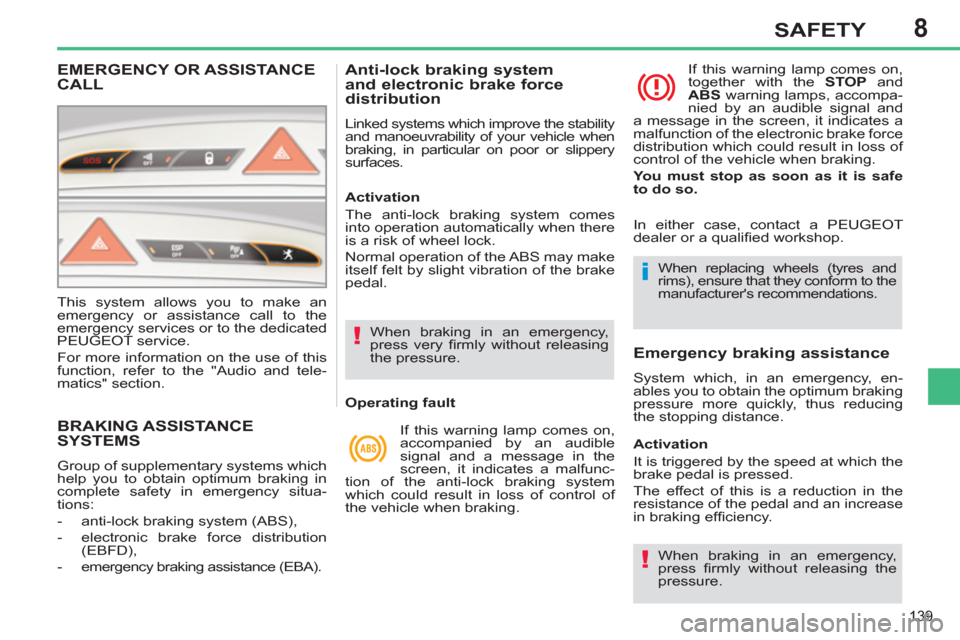
8
139
SAFETY
BRAKING ASSISTANCE SYSTEMS
Group of supplementary systems which
help you to obtain optimum braking in
complete safety in emergency situa-
tions:
- anti-lock braking system (ABS),
- electronic brake force distribution
(EBFD),
- emergency braking assistance (EBA).
Anti-lock braking system
and electronic brake force
distribution
Linked systems which improve the stability
and manoeuvrability of your vehicle when
braking, in particular on poor or slippery
surfaces.
When braking in an emergency,
press very fi rmly without releasing
the pressure.
When replacing wheels (tyres and
rims), ensure that they conform to the
manufacturer's recommendations.
Operating fault
If this warning lamp comes on,
accompanied by an audible
signal and a message in the
screen, it indicates a malfunc-
tion of the anti-lock braking system
which could result in loss of control of
the vehicle when braking. If this warning lamp comes on,
together with the STOP
and
ABS
warning lamps, accompa-
nied by an audible signal and
a message in the screen, it indicates a
malfunction of the electronic brake force
distribution which could result in loss of
control of the vehicle when braking.
You must stop as soon as it is safe
to do so.
Emergency braking assistance
System which, in an emergency, en-
ables you to obtain the optimum braking
pressure more quickly, thus reducing
the stopping distance.
Activation
The anti-lock braking system comes
into operation automatically when there
is a risk of wheel lock.
Normal operation of the ABS may make
itself felt by slight vibration of the brake
pedal.
Activation
It is triggered by the speed at which the
brake pedal is pressed.
The effect of this is a reduction in the
resistance of the pedal and an increase
in braking effi ciency. In either case, contact a PEUGEOT
dealer or a qualifi ed workshop.
When braking in an emergency,
press fi rmly without releasing the
pressure.
EMERGENCY OR ASSISTANCECALL
This system allows you to make an
emergency or assistance call to the
emergency services or to the dedicated
PEUGEOT service.
For more information on the use of this
function, refer to the "Audio and tele-
matics" section.
Page 142 of 382
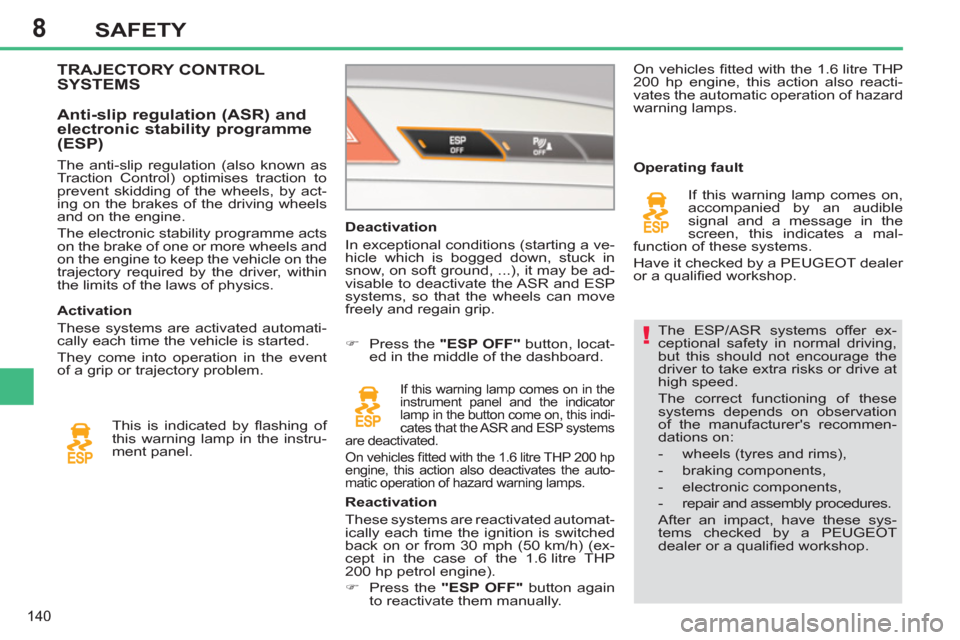
8
140
SAFETY
The ESP/ASR systems offer ex-
ceptional safety in normal driving,
but this should not encourage the
driver to take extra risks or drive at
high speed.
The correct functioning of these
systems depends on observation
of the manufacturer's recommen-
dations on:
- wheels (tyres and rims),
- braking components,
- electronic components,
- repair and assembly procedures.
After an impact, have these sys-
tems checked by a PEUGEOT
dealer or a qualifi ed workshop.
Deactivation
In exceptional conditions (starting a ve-
hicle which is bogged down, stuck in
snow, on soft ground, ...), it may be ad-
visable to deactivate the ASR and ESP
systems, so that the wheels can move
freely and regain grip.
�)
Press the "ESP OFF"
button, locat-
ed in the middle of the dashboard.
If this warning lamp comes on in the
instrument panel and the indicator
lamp in the button come on, this indi-
cates that the ASR and ESP systems
are deactivated.
On vehicles fi tted with the 1.6 litre THP 200 hp
engine, this action also deactivates the auto-
matic operation of hazard warning lamps.
Reactivation
These systems are reactivated automat-
ically each time the ignition is switched
back on or from 30 mph (50 km/h) (ex-
cept in the case of the 1.6 litre THP
200 hp petrol engine).
�)
Press the "ESP OFF"
button again
to reactivate them manually.
Operating fault
If this warning lamp comes on,
accompanied by an audible
signal and a message in the
screen, this indicates a mal-
function of these systems.
Have it checked by a PEUGEOT dealer
or a qualifi ed workshop.
TRAJECTORY CONTROLSYSTEMS
Activation
These systems are activated automati-
cally each time the vehicle is started.
They come into operation in the event
of a grip or trajectory problem.
Anti-slip regulation (ASR) and
electronic stability programme
(ESP)
This is indicated by fl ashing of
this warning lamp in the instru-
ment panel.
The anti-slip regulation (also known as
Traction Control) optimises traction to
prevent skidding of the wheels, by act-
ing on the brakes of the driving wheels
and on the engine.
The electronic stability programme acts
on the brake of one or more wheels and
on the engine to keep the vehicle on the
trajectory required by the driver, within
the limits of the laws of physics. On vehicles fi tted with the 1.6 litre THP
200 hp engine, this action also reacti-
vates the automatic operation of hazard
warning lamps.
Page 152 of 382
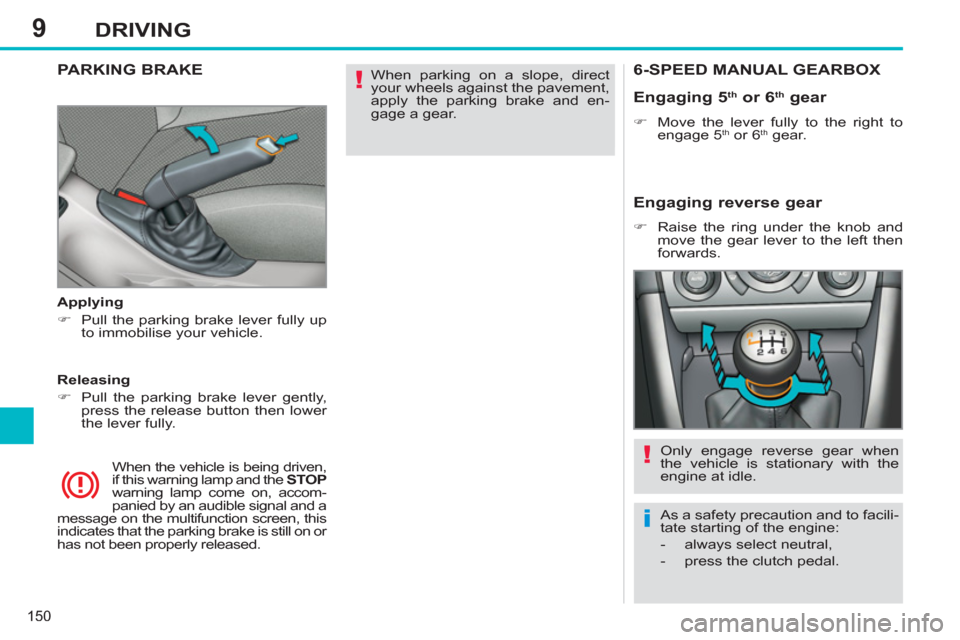
9
150
DRIVING
When parking on a slope, direct
your wheels against the pavement,
apply the parking brake and en-
gage a gear.
PARKING BRAKE
Applying
�)
Pull the parking brake lever fully up
to immobilise your vehicle.
When the vehicle is being driven,
if this warning lamp and the STOP
warning lamp come on, accom-
panied by an audible signal and a
message on the multifunction screen, this
indicates that the parking brake is still on or
has not been properly released.
Releasing
�)
Pull the parking brake lever gently,
press the release button then lower
the lever fully.
6-SPEED MANUAL GEARBOX
Engaging 5
th
or 6 th
gear
�)
Move the lever fully to the right to
engage 5 th or 6 th
gear.
Engaging reverse gear
�)
Raise the ring under the knob and
move the gear lever to the left then
forwards.
Only engage reverse gear when
the vehicle is stationary with the
engine at idle.
As a safety precaution and to facili-
tate starting of the engine:
- always select neutral,
- press the clutch pedal.
Page 154 of 382

9DRIVING
HILL START ASSIST *
System which keeps your vehicle im-
mobilised temporarily (approximately
2 seconds) when starting on a gradi-
ent, the time it takes to move your foot
from the brake pedal to the accelerator
pedal.
This function is only active when:
- the vehicle is completely stationary,
with your foot on the brake pedal,
- in particular conditions on a slope,
- with the driver’s door closed.
The hill start assist cannot be deacti-
vated.
On an ascending slope, with the ve-
hicle stationary, the vehicle is held
for a brief moment when you release
the brake pedal and you are in fi rst
gear or neutral.
Operation
On a descending slope, with the ve-
hicle stationary and reverse gear en-
gaged, the vehicle is held for a brief
moment when you release the brake
pedal.
*
Model fi tted with the 1.6 litre THP 200 hp
petrol engine.
Do not exit the vehicle while it is
being held in the hill start assist
phase.
Operating fault
If a malfunction of the system occurs,
these warning lamps come on. Have
it checked by a PEUGEOT dealer or a
qualifi ed workshop.
If you need to exit the vehi-
cle with the engine running,
apply the parking brake
and ensure that this warn-
ing lamp in the instrument
panel is on fi xed.
Page 155 of 382
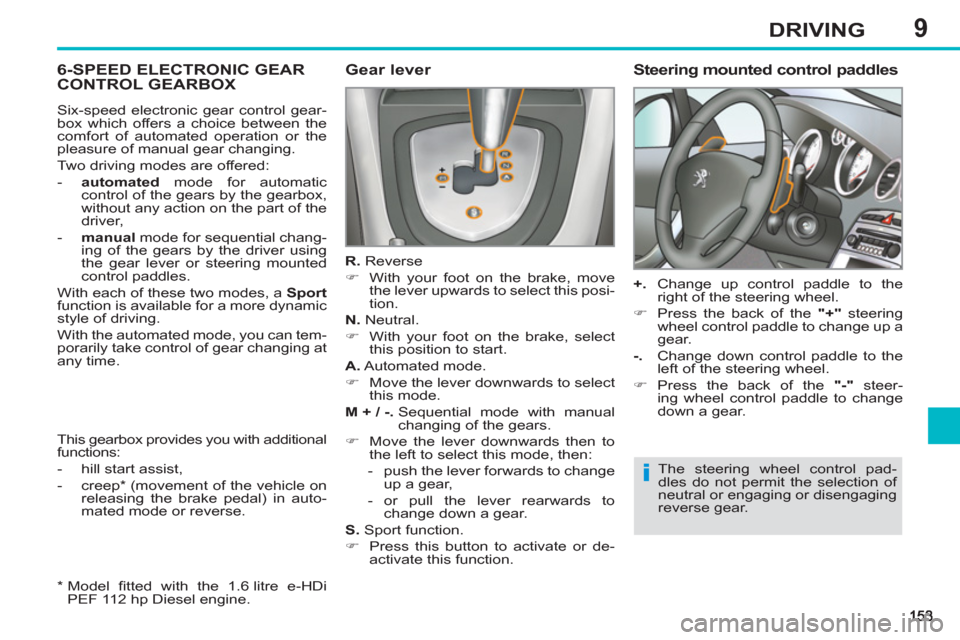
9DRIVING
6-SPEED ELECTRONIC GEAR
CONTROL GEARBOX
Gear lever
R.
Reverse
�)
With your foot on the brake, move
the lever upwards to select this posi-
tion.
N.
Neutral.
�)
With your foot on the brake, select
this position to start.
A.
Automated mode.
�)
Move the lever downwards to select
this mode.
M + / -.
Sequential mode with manual
changing of the gears.
�)
Move the lever downwards then to
the left to select this mode, then:
- push the lever forwards to change
up a gear,
- or pull the lever rearwards to
change down a gear.
S.
Sport function.
�)
Press this button to activate or de-
activate this function.
Steering mounted control paddles
+.
Change up control paddle to the
right of the steering wheel.
�)
Press the back of the "+"
steering
wheel control paddle to change up a
gear.
-.
Change down control paddle to the
left of the steering wheel.
�)
Press the back of the "-"
steer-
ing wheel control paddle to change
down a gear.
The steering wheel control pad-
dles do not permit the selection of
neutral or engaging or disengaging
reverse gear. Six-speed electronic gear control gear-
box which offers a choice between the
comfort of automated operation or the
pleasure of manual gear changing.
Two driving modes are offered:
- automated
mode for automatic
control of the gears by the gearbox,
without any action on the part of the
driver,
- manual
mode for sequential chang-
ing of the gears by the driver using
the gear lever or steering mounted
control paddles.
With each of these two modes, a Sport
function is available for a more dynamic
style of driving.
With the automated mode, you can tem-
porarily take control of gear changing at
any time.
This gearbox provides you with additional
functions:
- hill start assist,
- creep * (movement of the vehicle on
releasing the brake pedal) in auto-
mated mode or reverse.
*
Model fi tted with the 1.6 litre e-HDi
PEF 112 hp Diesel engine.
Page 156 of 382
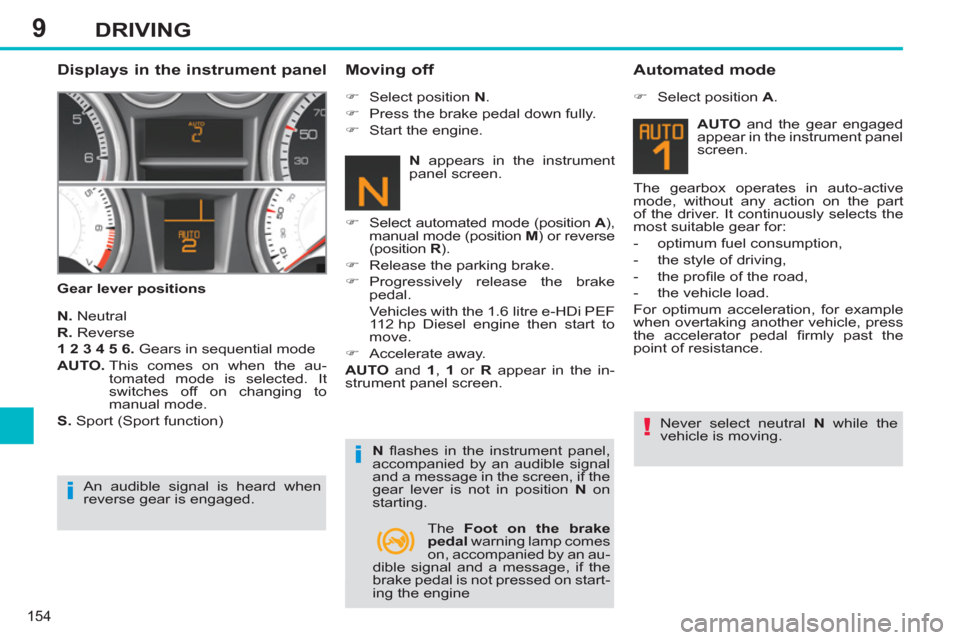
9
154
DRIVING
Displays in the instrument panel
Gear lever positions
Moving off
N.
Neutral
R.
Reverse
1 2 3 4 5 6.
Gears in sequential mode
AUTO.
This comes on when the au-
tomated mode is selected. It
switches off on changing to
manual mode.
S.
Sport (Sport function)
�)
Select position N
.
�)
Press the brake pedal down fully.
�)
Start the engine.
�)
Select automated mode (position A
),
manual mode (position M
) or reverse
(position R
).
�)
Release the parking brake.
�)
Progressively release the brake
pedal.
Vehicles with the 1.6 litre e-HDi PEF
112 hp Diesel engine then start to
move.
�)
Accelerate away.
AUTO
and 1
, 1
or R
appear in the in-
strument panel screen.
N
fl ashes in the instrument panel,
accompanied by an audible signal
and a message in the screen, if the
gear lever is not in position N
on
starting.
Automated mode
�)
Select position A
.
Never select neutral N
while the
vehicle is moving. The gearbox operates in auto-active
mode, without any action on the part
of the driver. It continuously selects the
most suitable gear for:
- optimum fuel consumption,
- the style of driving,
- the profi le of the road,
- the vehicle load.
For optimum acceleration, for example
when overtaking another vehicle, press
the accelerator pedal fi rmly past the
point of resistance.
N
appears in the instrument
panel screen.
An audible signal is heard when
reverse gear is engaged.
AUTO
and the gear engaged
appear in the instrument panel
screen.
The Foot on the brake
pedal
warning lamp comes
on, accompanied by an au-
dible signal and a message, if the
brake pedal is not pressed on start-
ing the engine
Page 157 of 382
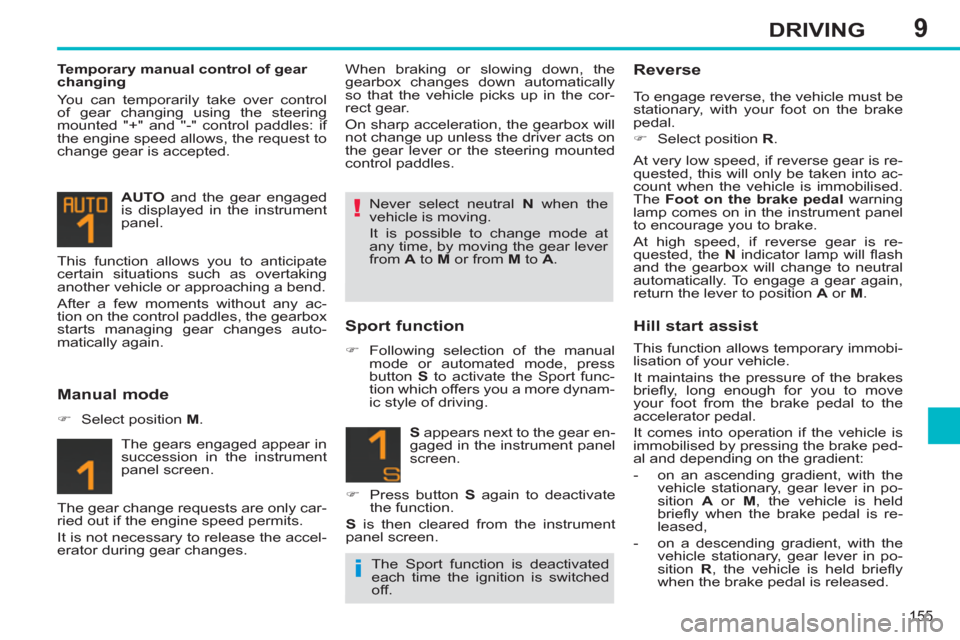
9
155
DRIVING
Temporary manual control of gear
changing
You can temporarily take over control
of gear changing using the steering
mounted "+" and "-" control paddles: if
the engine speed allows, the request to
change gear is accepted.
AUTO
and the gear engaged
is displayed in the instrument
panel. When braking or slowing down, the
gearbox changes down automatically
so that the vehicle picks up in the cor-
rect gear.
On sharp acceleration, the gearbox will
not change up unless the driver acts on
the gear lever or the steering mounted
control paddles.
The gears engaged appear in
succession in the instrument
panel screen.
Manual mode
�)
Select position M
.
Sport function
�)
Following selection of the manual
mode or automated mode, press
button S
to activate the Sport func-
tion which offers you a more dynam-
ic style of driving. Never select neutral N
when the
vehicle is moving.
It is possible to change mode at
any time, by moving the gear lever
from A
to M
or from M
to A
.
This function allows you to anticipate
certain situations such as overtaking
another vehicle or approaching a bend.
After a few moments without any ac-
tion on the control paddles, the gearbox
starts managing gear changes auto-
matically again.
S
appears next to the gear en-
gaged in the instrument panel
screen.
�)
Press button S
again to deactivate
the function.
S
is then cleared from the instrument
panel screen.
Reverse
To engage reverse, the vehicle must be
stationary, with your foot on the brake
pedal.
�)
Select position R
.
At very low speed, if reverse gear is re-
quested, this will only be taken into ac-
count when the vehicle is immobilised.
The Foot on the brake pedal
warning
lamp comes on in the instrument panel
to encourage you to brake.
At high speed, if reverse gear is re-
quested, the N
indicator lamp will fl ash
and the gearbox will change to neutral
automatically. To engage a gear again,
return the lever to position A
or M
.
The gear change requests are only car-
ried out if the engine speed permits.
It is not necessary to release the accel-
erator during gear changes.
Hill start assist
This function allows temporary immobi-
lisation of your vehicle.
It maintains the pressure of the brakes
briefl y, long enough for you to move
your foot from the brake pedal to the
accelerator pedal.
It comes into operation if the vehicle is
immobilised by pressing the brake ped-
al and depending on the gradient:
- on an ascending gradient, with the
vehicle stationary, gear lever in po-
sition A
or M
, the vehicle is held
briefl y when the brake pedal is re-
leased,
- on a descending gradient, with the
vehicle stationary, gear lever in po-
sition R
, the vehicle is held briefl y
when the brake pedal is released. The Sport function is deactivated
each time the ignition is switched
off.